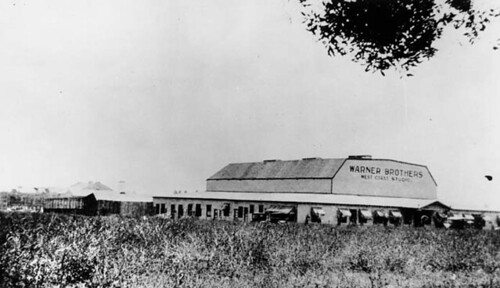The Brothers Warner (Cass Warner, 2008): USA
Reviewed by Collier Grimm. Viewed at the 2009 Santa Barbara International Film Festival.
 Today Warner Brothers represents a corporate movie studio owned by an even bigger corporation. In Cass Warner’s documentary, The Brothers Warner, she interviews people on the street who relate the name to The Looney Toons, and jokingly assume the company name comes from someone named Time Warner. However, during the classical film era the name was synonymous with films like I’m a Fugitive From a Chain Gang and Public Enemy. Warner Brother Films were tough, lean, and hard. The Studio was known for its grit, dangerous gangster flicks, and hard-hitting contract stars like Paul Muni, James Cagney, and Bette Davis. Founded in 1918 by four brothers, Warner Brothers produced the first talking picture, The Jazz Singer (1927), and became one of the “Big Five” movie studios that dominated Hollywood for years.
Today Warner Brothers represents a corporate movie studio owned by an even bigger corporation. In Cass Warner’s documentary, The Brothers Warner, she interviews people on the street who relate the name to The Looney Toons, and jokingly assume the company name comes from someone named Time Warner. However, during the classical film era the name was synonymous with films like I’m a Fugitive From a Chain Gang and Public Enemy. Warner Brother Films were tough, lean, and hard. The Studio was known for its grit, dangerous gangster flicks, and hard-hitting contract stars like Paul Muni, James Cagney, and Bette Davis. Founded in 1918 by four brothers, Warner Brothers produced the first talking picture, The Jazz Singer (1927), and became one of the “Big Five” movie studios that dominated Hollywood for years.
Warner’s documentary chronicles the Warner Brother dynasty before and during the studio era and up until youngest brother Jack made a serious business and brotherly error. The Warner brothers were Jewish immigrants from Poland seeking education and religious asylum. In 1903 they saw their first Nickelodeon and the future of moving pictures.
Soon Harry, the oldest, found the means to purchase a Kinetoscope camera that came with Edwin S. Porter’s, The Great Train Robbery. Cass Warner humorously remarks in her voice- over commentary that during her research for the film she found that Harry was remarkably slick at finding investors and lenders. The boys “set up theater” complete with a sheet hanging on the wall and chairs rented from the funeral parlor next door. Harry collected the money, Sam and Albert cranked the camera and fed the film, their sister played the organ, and young Jack “sang”- a term used to describe a method for chasing audiences out of the theater at films end. Soon the brothers discovered that distribution was much more profitable than exhibition and headed for California to start their own production studio.
Albert was in charge of distribution, Harry worked on the money side of things, Sam was the main producer, and Jack was there for the day to day shooting and acted as the face of the company- much to all three older brothers dislike. Harry sought to use film as a tool for social good and considered it the most important medium of the modern era. Public outcry from “Chain Gang”, which revealed the harsher realities of the US prison system, caused prison reform. Gangster Films produced by Warner Brothers revealed the underside of America, and always came with the message that evil forces would be prosecuted and punished. During World War 2 the studio used the camera as a propaganda tool, hoping to boost soldier and home front moral, and send footage home to anxious audiences. Two of the studios biggest stars, Bette Davis and John Garfield, went so far as to open the Hollywood Canteen with food, dancing, and entertainment for servicemen.
Cass Warner incorporates archival footage, old photographs, film clips, home movies, animation, and interviews to educate audiences on her relatives. The film is glittered with famous talking heads: Debbie Reynolds, Angie Dickinson, Dennis Hopper, Samuel Goldwyn Jr., and Roy Disney Jr. who reveals that Mickey Mouse and Steamboat Willy were a direct result of Warner Brothers inspirational first talking picture. Cass Warner has obviously made an effort to create a non-personal presentation of history and is very forgiving of her great uncle Jack who basically stabbed his brothers in the back and sold out. During the Q & A after the film, Warner revealed that the original film was over six hours long, but she had to cut it down. I would like to see it again in full length, perhaps as a series, and learn more about the actual studio-less about the family drama- or at least equal parts of both.
About this entry
You’re currently reading “The Brothers Warner (Cass Warner, 2008): USA,” an entry on Student Film Reviews
- Published:
- 02.04.09 / 9pm
- Category:
- Documentary, Films, Santa Barbara Film Festival 2009
No comments
Jump to comment form | comments rss [?] | trackback uri [?]